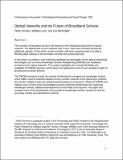| dc.description.abstract | The evolution of broadband services will depend on the widespread deployment of optical
networks. The deployment of such networks will, in turn, help drive increased demand for
additional capacity. In this world, service providers will have a growing need to be able to
flexibly adjust capacity to accommodate uncertain and growing demand.
In this article, we present a cost model that highlights the advantages of new optical networking
technologies such as Dense Wavelength Division Multiplexing (DWDM) over traditional
architectures for optical networks. This analysis highlights the increased flexibility and
scalability of DWDM networks, which lowers the deployment costs of such networks in light of
growing and uncertain demand.
The DWDM architecture holds the promise of allowing the emergence of wavelength markets,
where traffic could be switched between service provider networks at the optical layer (without
the need for multiple costly and wasteful electronic/optical conversions). While the DWDM and
Optical Cross-Connect (OxC) technologies provide a technical infrastructure for supporting
wavelength markets, additional developments are also likely to be required. This paper also
considers some of the impediments to the growth of wavelength markets, namely the need for
secondary markets and standardized contracts. | en |
